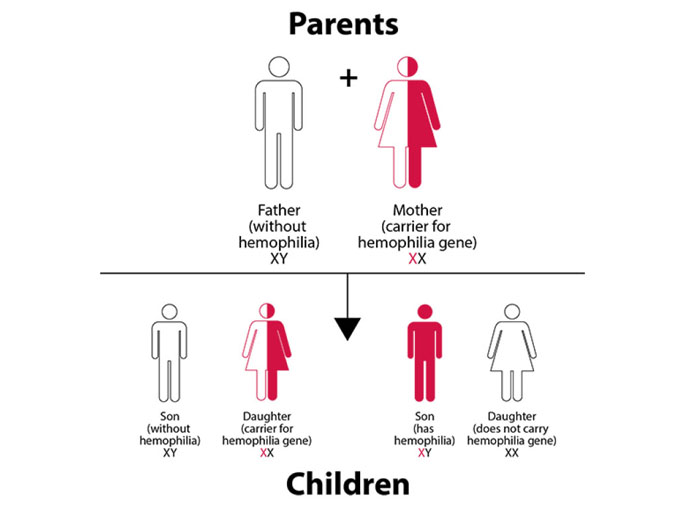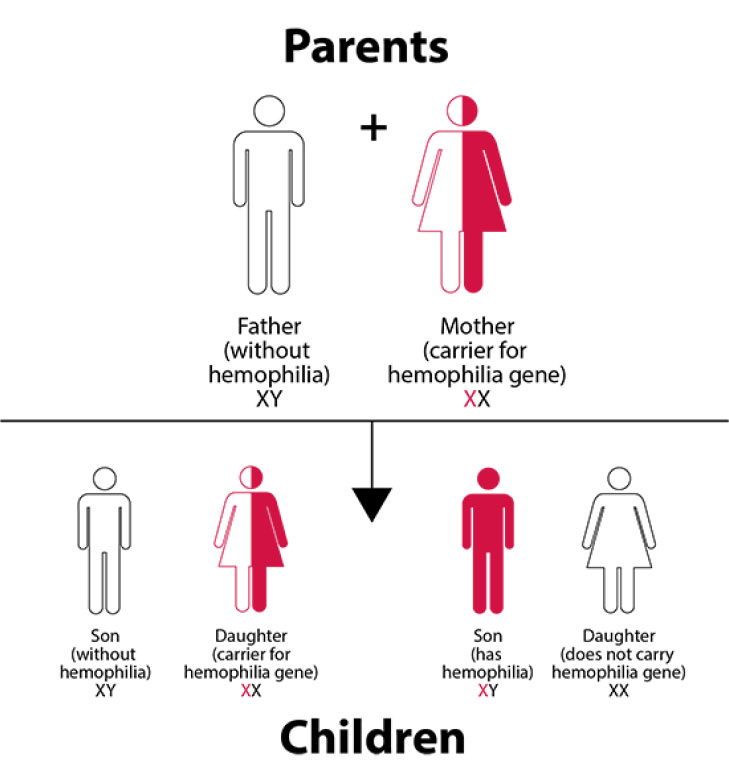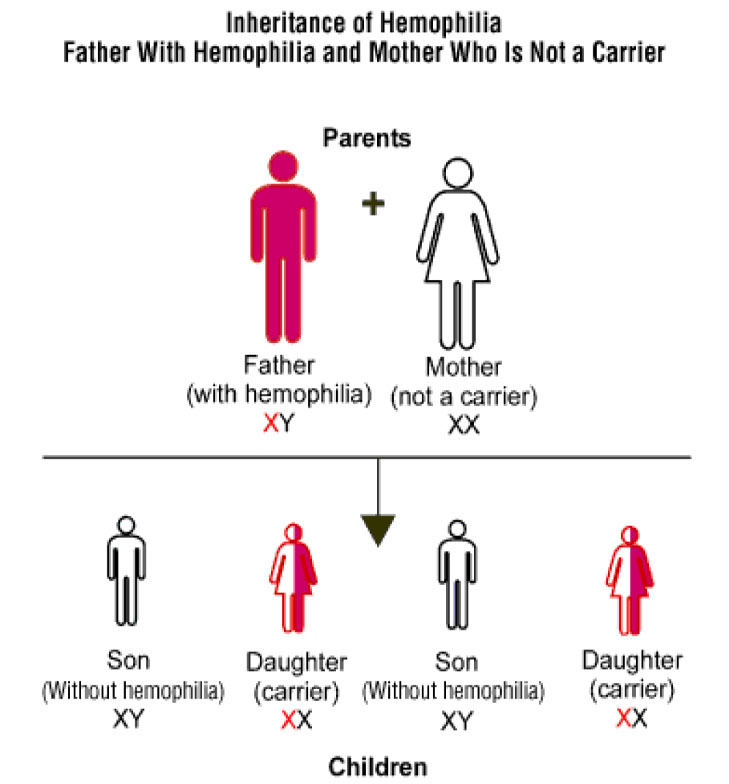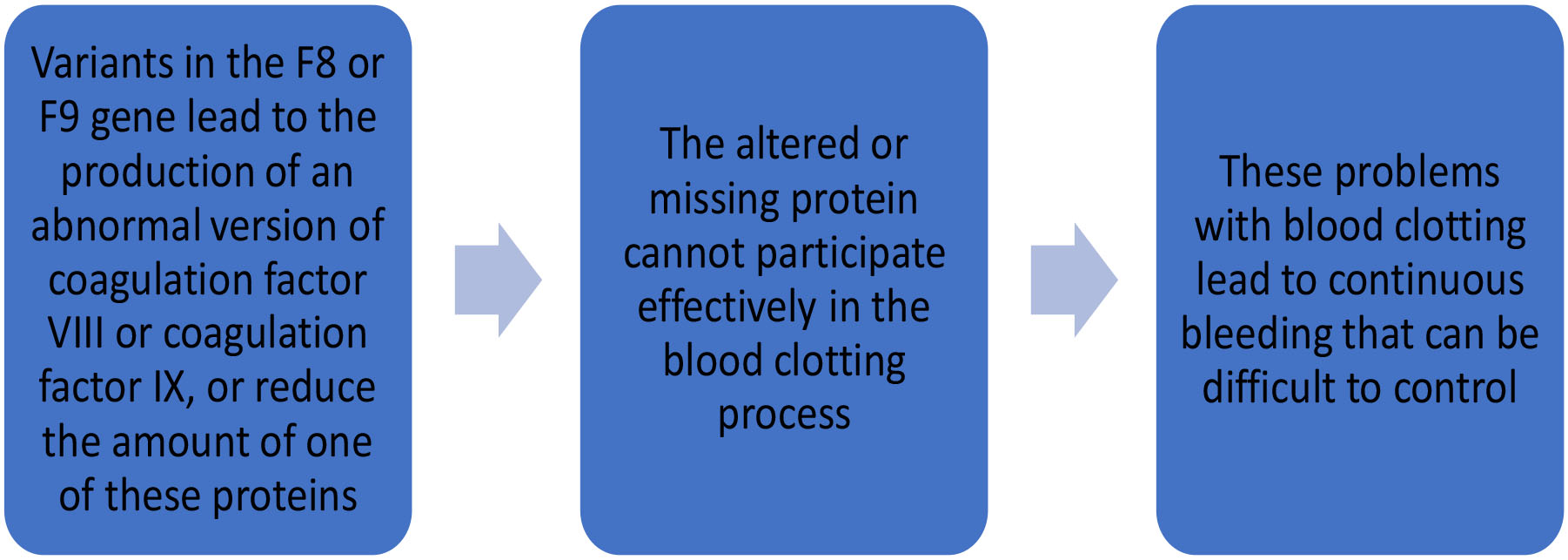- NEED HELP? CALL US NOW
- +919995411505
- [email protected]

Hemophilia is a common hereditary coagulation blood disorder due to deficiency or reduced activity of clotting factor VIII or clotting factor IX.
- This disorder is a X- linked recessive disorder.
- Hemophilia is a bleeding disorder that slows down the blood clotting process.
- It’s transmitted via females to men who are sufferers.
According to the Centers for Disease Control and Prevention (CDC)Trusted Source, proteins called clotting factors work with platelets to stop bleeding at the site of an injury.
People with the most common types of hemophilia produce lower amounts of either factor VIII or factor IX. This means that the person tends to bleed for a longer time after an injury and is more susceptible to internal bleeding.
Causes
- Hemophilia is caused by a mutation or change, in one of the genes, that provides instructions for making the clotting factor proteins needed to form a blood clot.
- This change or mutation can prevent the clotting protein from working properly or to be missing altogether.
- These genes are located on the X chromosome.
- Males have one X and one Y chromosome (XY) and females have two X chromosomes (XX). Males inherit the X chromosome from their mothers and the Y chromosome from their fathers.
- Females inherit one X chromosome from each parent.
- The X chromosome contains many genes that are not present on the Y chromosome.
- This means that males only have one copy of most of the genes on the X chromosome, whereas females have 2 copies.
- Thus, males can have a disease like hemophilia if they inherit an affected X chromosome that has a mutation in either the factor VIII or factor IX gene.
- Females can also have hemophilia, but this is much rarer. In such cases both X chromosomes are affected, or one is affected and the other is missing or inactive. In these females, bleeding symptoms may be similar to males with hemophilia.
- A female with one affected X chromosome is a “carrier” of hemophilia.
Signs and symptoms of spontaneous bleeding include:
- Unexplained and excessive bleeding from cuts or injuries, or after surgery or dental work
- Many large or deep bruises
- Unusual bleeding after vaccinations
- Pain, swelling or tightness in your joints
- Blood in your urine or stool
- Nosebleeds without a known cause
- In infants, unexplained irritability
Types of hemophilia
There are two major types of hemophilia — type A and type B.
Both A and B can be:
|
Hemophilia A occurs due to a lack of clotting factor VIII. This type of hemophilia is four times more common than hemophilia B. Of those, more than half of people with hemophilia A have the severe form. |
Hemophilia B, colloquially known as Christmas disease, happens due to a lack of clotting factor IX. Hemophilia B occurs in around 1 in every 25,000 males born worldwide. |
Note
ACQUIRED HEMOPHILIA
Acquired hemophilia is a rare autoimmune disorder characterized by bleeding that occurs in patients with a personal and family history negative for hemorrhages.
Autoimmune disorders occur when the body’s immune system mistakenly attacks healthy cells or tissue.
| Mild: Approximately 25% of cases are mild. A person with mild hemophilia has factor levels of 6–30%. |
| Moderate: Approximately 15% of cases a moderate, and a person with moderate hemophilia will have factor levels of 1–5%. |
| Severe: Approximately 60% of cases are severe, and people with severe hemophilia will have factor levels of less than 1%. |
Inheritance
There are three possible scenarios for inheriting hemophilia, depending on whether a mother or father (or both) is affected:
If the mother has one altered factor gene and the father does not have hemophilia, each son has a 50% chance of having hemophilia and each daughter has a 50% chance of having one altered factor gene, causing her to be a carrier or have hemophilia.

If the father has hemophilia, and the mother does not carry a hemophilia gene, then each son has a 0% chance of having hemophilia, and each daughter has a 100% chance of either being a carrier or having hemophilia.

If the father has hemophilia, and the mother is a carrier of the hemophilia gene, then each son has a 50% chance of having hemophilia, and each daughter has a 50% chance of having one altered factor gene causing her to be a carrier or have hemophilia, and a 50% chance of having two altered factor genes and having hemophilia.
Cause
- Variants in the F8 gene cause hemophilia A, while variants in the F9 gene cause hemophilia B.
- The F8 gene provides instructions for making a protein called coagulation factor VIII.
- A related protein, coagulation factor IX, is produced from the F9 gene.
- Coagulation factors are proteins that work together in the blood clotting process.
- After an injury, blood clots protect the body by sealing off damaged blood vessels and preventing excessive blood loss.

Diagnosis
- Prenatal testing: if a pregnant woman has a history of hemophilia, a hemophilia gene testing can be done during pregnancy.
- A sample of placenta is removed from the uterus and tested. The test is known as CVS ( Chorionic Villus Sampling) test.
- Blood studies A normal platelet count, normal PT, and prolonged aPTT are the characteristics of hemophilia A and B
- Specific test for blood clotting factors can then be performed to meassure factor VIII or factor IX level to confirm the diagnosis.
Management
- Treatment with replacement therapy: Concentrates of clotting factor VIII and IX
- Desmopressin – desmopressin (DDAVP) is a man made hormone used to treat people who have mild to moderate hemophilia A. – it is not used to treat Variants in the F8 or F9 gene lead to the production of an abnormal version of coagulation factor VIII or coagulation factor IX, or reduce the amount of one of these proteins The altered or missing protein cannot participate effectively in the blood clotting process These problems with blood clotting lead to continuous bleeding that can be difficult to control hemophilia B and severe hemophilia A – it is usually given as injections or nasal sprays.
- Antifibrinolytic medicines – it include trenaxamic acid and aminocaporic acid. – they are usually given as pills and they help to keep the blood clot from breaking down.
- Gene therapy – researches are going to correct the faulty genes that causes hemophilia.
- Analgesics – pain relievers may prescribed to relieve pain. – aspirin and NSAID are not using – naproxen and ibuprofen are used
- RICE Rest, Ice, Compression and Elevation is recommended by the professionals for joint bleeding. it also helps to reduce the swelling and tissue damage
- To take a well balanced die
- Advice to do regular exercise
- Teach the patient to avoid aspirin and other anticoagulants
- Provide a calm and quite environment to the patient
- Provide psychological support
- Maintain good IPR with the patient
Prevention of Hemophilia
- Early treatment of joint hemorrhages
- Arrest of synovitis: surgical removal, radiosynoviorthesis
- Use of higher doses, multiple infusions
- Prevention of bleeding with routine replacement of factor VIII on a regular schedule




